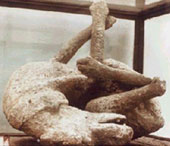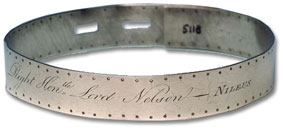If there is one thing that all us pups love it would have to be collars don’t you think? Nothing says your owned more then a collar and nothing can beat that feeling of being owned. Leeds Castle in England pays homage to just that! Dog Collars 🙂
So today is a little history lesson for all you pups and wruffs and pet lovers out there. So pay attention as some of this could be on the final exam…wruuff!! At the moment the Museum shows nearly 100 antique dog collars spanning about five centuries. Collars dating 
Dog-Collar Museum: Kent, England written by Kerry Banks in MyWestWorld
Although it is hard to believe that there’s a demand for this sort of thing, this  museum, located inside of Leeds Castle, attracts more than 500,000 visitors every year. The dog collar collection counts over 100 unique items that present the history of canine-wear starting from early medieval times to the Victorian Age. The dog collars were originally gathered by Irish medieval collector John Hurt and his wife Gertrude, and were donated to Leeds Castle in 1979, as a tribute to the castle’s last private owner, Lady Baillie, a major dog lover. The antique dog collars tell 500 years of canine history, from early, 15th century dog collars, filled with spikes to protect the neck of hunting hounds against wolves, boars and bears, to glamorous leather and velvet baroque collars of the 18th century. Engraved silver collars from the last century, some fashioned by leading silversmiths of the day, form an interesting section. Many come in pairs joined by short chains, such as those presented to Top and Tabinet engraved “The Property of Earl Talbot. The Winner of the Great Champion all aged (Puppy) stakes for all England 32 Dogs at 20 guin’s each at Ashdown Park. Dec 14th 1838.” Other inscriptions are less formal. An 18th century English brass collar simply states; “I am Mr Pratt’s Dog, King St, Nr Wokingham, Berks. Whose Dog are You?”
museum, located inside of Leeds Castle, attracts more than 500,000 visitors every year. The dog collar collection counts over 100 unique items that present the history of canine-wear starting from early medieval times to the Victorian Age. The dog collars were originally gathered by Irish medieval collector John Hurt and his wife Gertrude, and were donated to Leeds Castle in 1979, as a tribute to the castle’s last private owner, Lady Baillie, a major dog lover. The antique dog collars tell 500 years of canine history, from early, 15th century dog collars, filled with spikes to protect the neck of hunting hounds against wolves, boars and bears, to glamorous leather and velvet baroque collars of the 18th century. Engraved silver collars from the last century, some fashioned by leading silversmiths of the day, form an interesting section. Many come in pairs joined by short chains, such as those presented to Top and Tabinet engraved “The Property of Earl Talbot. The Winner of the Great Champion all aged (Puppy) stakes for all England 32 Dogs at 20 guin’s each at Ashdown Park. Dec 14th 1838.” Other inscriptions are less formal. An 18th century English brass collar simply states; “I am Mr Pratt’s Dog, King St, Nr Wokingham, Berks. Whose Dog are You?”
More Information On The Dog Museum Can Be Found Here
____________________
….and Now its time pups and puppets for a real history lesson about Dog Collars written by edman for DogCo that i found to be extremely interesting…and i hope by now you have realized i don’t post boring garbage on PupsTail so if my ADD pup self could sit and read this article without figgiting then so could you! – Original post found and more pics CLICK HERE
DO YOU REGARD your dog’s collar as simply a utilitarian item in the pet’s probably spartan wardrobe? Or is your dog’s collar encrusted with semi-precious stones, or jangling with highly polished, brass, vintage dog-license tags?
Today’s dog collar usually functions as just something on which to affix registration/license tags and dog ownership details as well as being a means of restraining and controlling a dog.
But for thousands of years dogs have worn both functional and decorative collars.
Ancient Egyptian hieroglyphs show hunting dogs wearing collars, both broad and narrow. These probably fell within the same categories as the dog collar of today … as a functional piece for restraint, a decorative accessory, but also as a protective band.
The Romans used broad collars studded with spikes to protect the throats of valued and loved animals from attacks by other dogs and wild beasts. Records from the Greek Battle of Corinth during the 5th century BC report that 50 dogs guarded the city and alerted the town of the attack. Just one dog survived and he was awarded a pension for life and a silver collar in recognition of his valour.
An example of a collar was preserved in the ruins of Pompeii where, in 69AD, Mt Vesuvius erupted, covering the town in layers of ash. One of the victims was a family dog and its body form, well preserved in the ash, reveals not only the shape of the animal but the collar it was wearing at the time of death.
Without doubt, up to the 19th century one of the main functions of a dog’s collar was to protect a vulnerable neck. But it is just as certain that a handsome collar was a symbol of status — not for the dog, but for its owner. It is noted that Egyptian dogs belonging to nobility wore collars made of gold, silver and other precious materials.
The flock-guardian dogs of the mountain regions of Europe, however, often wore a quite simple iron collar linked by spiked rings, once again for protection from attacks by wolves and bears. These collars were seen from the Middle Ages but can still be found in regions of Turkey and other areas of Europe today. They were produced by village blacksmiths, each of whom produced their unique particular design.
The 17th to 19th centuries saw the lined metal collar become popular and many fine examples can be found in museums and collections today. Typically, these collars were a simple brass design with rolled edges which prevented chaffing of the dog’s neck. A row of slits (usually between three and six) made the collar adjustable and these were fastened by a brass padlock.
Different materials were used for lining these dog collars including leather, fleece, velvet, chamois and wool felt. Often the collars bore inscriptions which could be as simple as an owner’s name or as ornate as a name supported by a coat of arms. Regimental badges appeared on the collars of canine military mascots.
Dog registration/license tags came into more widespread use in the later parts of the 19th century and this probably necessitated the availability of a cheaper collar for the masses.
Leather collars began to appear in Victorian times and were an obvious sideline for saddlers and harness-makers. These collars, in particular, were often embellished with small bells or flat studs.
Inscriptions on today’s dog collars generally bear the dog’s name and sometimes a telephone number but in the past collars were more likely to be decorated with the owner’s (rather than dog’s) name and address. Metal collars, particularly silver ones, were often considered to be worth more than the dog and collars were sometimes stolen and melted down.
Silver dog collar said to have been worn by Vice-Admiral Horatio Nelson’s dog, Nileus. Copperplate inscription says: Right Honble Lord Nelson – Nileus. Note the holes punched around the border of the collar to enables the stitching in of a cloth or leather lining.
One of the more famous inscriptions to appear on a dog collar is the epigram on the collar of a puppy presented in the early 18th century by poet Alexander Pope to the Prince of Wales. It stated: “I am his Highness’ dog at Kew, Pray tell me, sir, whose dog are you?”
At a similar time in history we have the report from author Jonathan Swift on Mrs Dingley’s lap-dog, Tiger, whose collar bore the inscription: “Pray steal me not; I’m Mrs Dingley’s, whose heart in this four-footed thing lies.”
Pope’s epigram was often bastardized and appeared in various forms such as on an 18th century English brass collar in the Leeds Castle Dog Collar Museum which simply states: “I am Mr Pratt’s Dog, King St, Nr Wokingham, Berks. Whose Dog are You?”
The bells, the bells … The latter part of the 19th century saw a fascination with putting bells on collars.
Another collar, which survives in the collection of Historic Deerfield museum in New England, USA, bears the inscription: “Jere Stebbin Esq’s Dog W. Springfield, Who Dog Be You?”
Today collars are designed by leading fashion houses such as Louis Vuitton, Burberry
, Gucci
and Coach
. And the dog with wanderlust can wear a collar with a GPS tracking system. You will also find collars embellished with crystal rhinestones, brass studs and silver charms. But if you have a hankering for something old, you can buy a replica of the Earl of Talbot’s dog collar which is on display in the Leeds Castle Dog Collar Museum. It comes in sterling silver, is made to order and will set you back something like $2400.
Links to buy your own antique dog collar :
ANTIQUE DOG COLLARS ON EBAY
- Antique Pooch Dog Collars
- Oli Collars
- Etsy Dog Collars
- Ruby Lane
- The Find
- Victorian Dog Collar













Pingback: stephanie olmo
Pingback: french bulldogs for sale ca
Pingback: frenchie for sale houston
Pingback: acupuncture
Pingback: Fort Lee
Pingback: probiotic dog treats
Pingback: French Bulldog For Sale
Pingback: French Bulldog Puppies Near Me
Pingback: golf cart rental
Pingback: blue french bulldog price
Pingback: mexican candy wholesale
Pingback: brazilian jiu jitsu cypress tx
Pingback: grey french bulldog
Pingback: how to get papers on a dog
Pingback: bulldog shih tzu mix
Pingback: French Bulldog Rescue
Pingback: French Bulldog Rescue
Pingback: French Bulldog Adoption
Pingback: French Bulldog Rescue
Pingback: rent a yacht in cancun
Pingback: french bulldog rescue
Pingback: french bulldog texas
Pingback: dog registration
Pingback: sugar land seo company
Pingback: Dog Papers
Pingback: Dog Registry
Pingback: Dog Registry
Pingback: Dog Registry
Pingback: Dog Registry
Pingback: Dog Registry
Pingback: Dog Papers
Pingback: Dog Registry
Pingback: Dog Registry
Pingback: Dog Registry
Pingback: Dog Breed Registries
Pingback: Dog Breed Registries
Pingback: How To Obtain Dog Papers
Pingback: Dog Papers
Pingback: Dog Papers
Pingback: Dog Papers
Pingback: How To Obtain Dog Papers
Pingback: Dog Breed Registries
Pingback: How To Obtain Dog Papers
Pingback: How To Obtain Dog Papers
Pingback: french bulldog chihuahua mix
Pingback: probiotics for french bulldogs
Pingback: probiotics for english bulldogs
Pingback: french pitbull
Pingback: boston terrier french bulldog mix
Pingback: chamoy dulce
Pingback: bjj jiu jitsu magnolia texas
Pingback: french bulldog
Pingback: french bulldog
Pingback: gaming
Pingback: sui
Pingback: coco chanel dog collar
Pingback: french bulldog usa
Pingback: french bulldog puppies for sale in texas
Pingback: mexican candy store near me
Pingback: mexican candy store near me
Pingback: mexican candy store near me
Pingback: mexican candy store near me
Pingback: mexican candy store near me
Pingback: french bulldog texas
Pingback: we buy french bulldog puppies
Pingback: dr kim acupuncture
Pingback: dog probiotic chews
Pingback: boston terrier for sale in massachusetts
Pingback: wix seo
Pingback: yorkie poo breeding
Pingback: 늑대닷컴
Pingback: house of ho
Pingback: 늑대닷컴
Pingback: sole mare vacanze t-shirt
Pingback: french bulldog puppies for sale houston texas
Pingback: elizabeth kerr
Pingback: hairdresser in houston
Pingback: rent a yacht in cancun
Pingback: isla mujeres condo
Pingback: best probiotic for french bulldogs
Pingback: condiciones climaticas queretaro
Pingback: chamy rim dips
Pingback: aimbot delta force
Pingback: halo infinite ESP
Pingback: valorant mod
Pingback: french bulldog puppies near me
Pingback: french bulldog
Pingback: designer dogs
Pingback: french bulldog rescue
Pingback: clima en chimalhuacan
Pingback: esports domain
Pingback: Instagram URL Shortener
Pingback: Buy Cisco
Pingback: Buy Cisco
Pingback: Buy Cisco
Pingback: Buy Cisco
Pingback: Buy Cisco
Pingback: Buy Cisco
Pingback: Buy Cisco
Pingback: online betting
Pingback: 1922 morgan silver dollar
Pingback: Find great deals with bed bath and beyond bonus coupon
Pingback: elektrik
Pingback: xbox 720 release
Pingback: Uncover Coupon For Bed Bath And Beyond
Pingback: carl ken
Pingback: Smart Shopping at Bed Bath and Beyond
Pingback: used car warranties nsw
Pingback: Spawn to Sub
Pingback: mountain bikes
Pingback: Calculate Mushroom Substrate